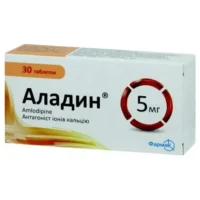Description
Aritmil (Amiodarone Hydrochloride) Tablets 0.2 №50
Ingredients
Active ingredient: Amiodarone hydrochloride
Mechanism of Action
Amiodarone hydrochloride exerts its antiarrhythmic effects by prolonging the action potential duration and refractory period of cardiac tissues. This action helps in controlling irregular heart rhythms and preventing the recurrence of arrhythmias.
Pharmacological Properties
Amiodarone hydrochloride, the primary component of Aritmil tablets, belongs to the class III antiarrhythmic agents. It exhibits multiple electrophysiological effects on the heart, including blocking potassium channels, sodium channels, and calcium channels, thereby affecting the cardiac action potential.
Indications for Use
Indications: Aritmil tablets are indicated for the treatment of various types of irregular heartbeats, including ventricular arrhythmias and atrial fibrillation.
Contraindications
Contraindications: Do not use Aritmil if you have a known hypersensitivity to amiodarone or any of the tablet’s components. Patients with severe sinus node dysfunction, severe bradycardia, or second- or third-degree heart block should also avoid using Aritmil tablets.
Side Effects
Common side effects of Aritmil tablets may include photosensitivity, thyroid dysfunction, pulmonary toxicity, gastrointestinal disturbances, and corneal microdeposits. Serious but rare side effects may include pulmonary fibrosis, liver toxicity, and cardiac arrhythmias.
Usage Instructions
Dosage: The usual dose of Aritmil tablets is 200-400 mg daily, taken as a single dose or divided into smaller doses. Dosage adjustments may be necessary based on individual patient response and tolerability.
Benefits Compared to Analogues
Aritmil offers the advantage of a broad spectrum of antiarrhythmic activity, making it effective in managing various types of arrhythmias. Compared to some analogues, Aritmil has a lower risk of proarrhythmia and a well-established track record in treating complex arrhythmias.
Suitable Patient Groups
Aritmil tablets can be used in adult patients, including the elderly, with close monitoring of organ functions. However, caution is advised in pediatric populations due to the potential for adverse effects on growth and development.
Storage and Shelf Life
Store Aritmil tablets in a cool, dry place away from direct sunlight. Keep the tablets in their original packaging to protect them from moisture. Check the expiration date on the packaging and do not use expired tablets.
Packaging Description
Aritmil tablets are available in blister packs containing 50 tablets. Each tablet is film-coated for easy swallowing and protection from environmental factors.
Scientific Evidence
Several clinical trials have demonstrated the efficacy of amiodarone in managing various types of arrhythmias, including life-threatening ventricular arrhythmias. A study published in the New England Journal of Medicine showed that amiodarone significantly reduced the incidence of sudden cardiac death in patients with ventricular arrhythmias.
Additional Information
It is crucial to monitor thyroid function, liver enzymes, and lung function regularly during treatment with Aritmil tablets, as amiodarone can affect these organ systems. Consult your healthcare provider for proper monitoring and dose adjustments.
Aritmil tablets should be taken with food to improve absorption and reduce the risk of gastrointestinal side effects. Avoid grapefruit juice while taking this medication, as it may increase the levels of amiodarone in the blood.





